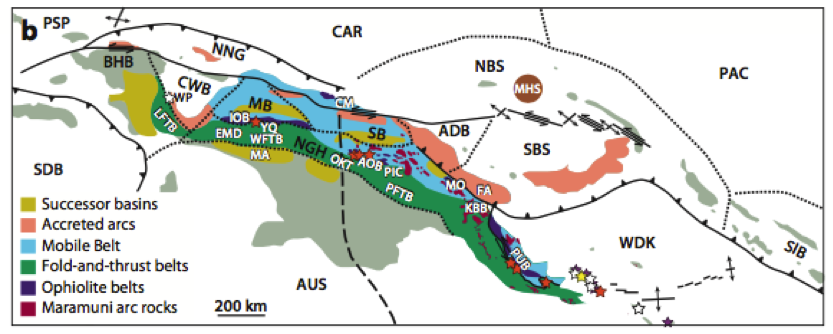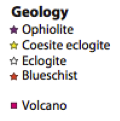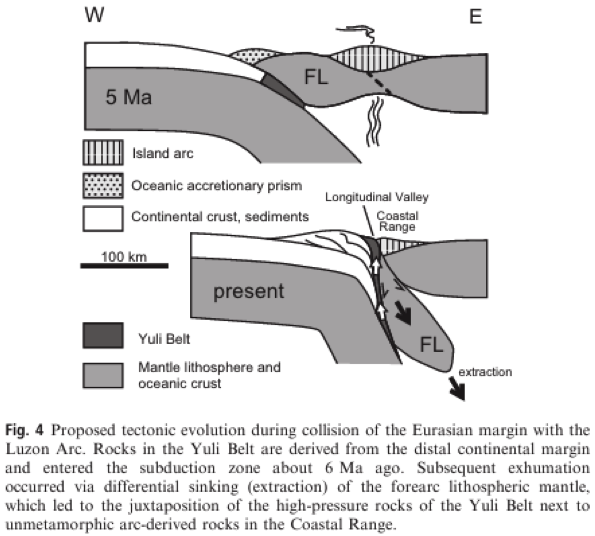


Figure 1 From Baldwin et al., 2012. This map shows the location of blueschist localities in Papua New Guinea, denoted by orange stars.
Rachel Havranek
In Hildebrand (2009) and Hildebrand (2013), the author proposes a novel mechanism by which the Phanerozoic tectonic history of the Western U.S. may be reinterpreted. Rather than the classical interpretation of a long-lived eastward dipping subduction zone, Hildebrand proposes that North America collided with the ribbon continent Rubia. In this hypothesis, the western edge of North America subducted beneath the Panthallasic side of Rubia during the Cretaceous period. This hypothesis predicts that we should observe igneous and metamorphic rocks associated with subduction zones from Utah northward though the Canadian section of Rubia. In particular, this model predicts that subducted material underwent blueschist facies metamorphism and should be present near the suture zone between the two continents. The purpose of this paper is twofold: firstly, to test the validity of the prediction by assessing if the presence of blueschist facies rocks are indicative of this tectonic setting and secondly, to identify blueschist facies rocks around the proposed suture zone between Rubia and North America.
The blueschist facies describes a set of pressure-temperature conditions found in subduction zones where high pressures (i.e. 5-6 kbar) can be achieved in combination with low temperatures (i.e. 200-500°C). To maintain their prograde mineralogical composition, blueschists are emplaced onto continental crust via rapid exhumation (Winter, 2014). The protolith that enters the subduction zone determines the mineralogical composition of the exhumed metamorphic rocks. Blueschists formed from basaltic protoliths are composed of glaucophane + lawsonite and/or epidote + garnet + quartz schists. A more pelitic protolith will display kyanite + zoisite + albite + quartz (+garnet) (Winter, 2014). We may also expect to find metamorphic rocks that have subsequently undergone metamorphism that may preserve part of these metamorphic assemblages.
|
Figure 1 From Baldwin et al., 2012. This map shows the location of blueschist localities in Papua New Guinea, denoted by orange stars. |
The prediction that we should observe blueschists in the suture zone between the two continents is reasonable based on what we observe in modern analogues of a collision between North American and a ribbon continent. The first modern analog is the collision between New Guinea and Australia (figure 1). In New Guinea there are three localities of blueschists. The first are found in the South Sepik Region (Baldwin et al., 2012). These were a part of the Paleogene arc system that is now accreted onto the terrane, and is within the continent – arc collision zone (Rayburn, 1980). Blueschists in the Tau body were formed from a pelitic protolith, and thus serve as an appropriate analog for North America because we expect that sediments associated with the transition between the North American platform and Antler platform would have been associated with prograde metamorphism during collision (Baldwin et al., 2012). The final exposure of blueschists in New Guinea occur in the Emo Metamorphic complex. These rocks are a sliver of oceanic crust that were obducted in association with the Papuan ophiolite (Baldwin et al., 2012). The blueschists of New Guinea are helpful because it demonstrates the different kinds of protoliths we may expect in the subduction of North America. However, this example’s applicability is limited, because the fault system in New Guinea is very complicated, and does not represent a more simplistic suturing of a continent and island arc that is suggested by Hildebrand.
 |
Fig. 2. From Sandmann et al., 2015. This figure demonstrates how foundering of the plate led to blueschist exhumation |
The collision between Taiwan and the Chinese passive margin is the second is modern analogue of collision between North America and Rubia (Sandmann et al., 2015). The Yuli belt blueschists record the collision of Eurasia with the Luzon island arc (Figure 2). The schists were exhumed in an opening gap created when the forearc lithosphere was removed by discrete subduction (Sandmann et al., 2015). This gap is analogous to the break in collision that Hildebrand proposed that allowed for the cessation of Sevier deformation. Thus, we readily predict that we should have the opportunity to exhume blueschists in North America. Additionally, this analogue makes a prediction about where we should find blueschists in North America– they should be juxtaposed against unmetamorphosed sediments and volcanic rocks associated with subduction (Sandman et al., 2015). Finally, blueschists associated with the formation of Proto-Rubia (e.g. in the Cache Creek Terrane), as well as on the western edge of Rubia, associated with the eastward dipping subduction are preserved today, indicate that the preservation of blueschists from the subduction of North America is reasonable to expect (Hildebrand, 2013).
The proposed suture zone between Rubia and North America is in eastern Utah and extends northwards through Idaho, all the way up to the eastern edge of Alaska. To evaluate Hildebrand’s hypothesis, I searched for blueshist facies metamorphism present along the suture zone area. Geologic maps from Utah, Idaho, Montana, and Alberta reveal a lack of blueschist facies rocks present (Hintze et al., 2000, Vuke et al., 2007, Lewis et al., 2012, Wheeler et al., 1996). Though there are no blueschists in the area, the possibility remains that the blueschist metamorphism predates other metamorphic events, and thus would have been overprinted.
To determine if subsequent metamorphism was responsible for overprinting subduction zone metamorphism, literature was consulted for geochronological and protolith constraints on existing greenschist facies and higher metamorphism. In the Canadian Shuswap complex the development of the core complexes has been dated to the late Triassic, early Jurrassic, which predates the supposed juxtaposition of North America with Rubia (Armstrong, 1980). This eliminates the possibility that subsequent metamorphism overprinted subduction metamorphism in Canada. One promising location of metamorphism occurs in the Belt-Purcell group of Montana during the Late Cretaceous – Eocene. However, the metamorphism only locally reached the Phrenite – Pumpelyite facies metamorphism, in which case we would not expect to see all blueschist facies textures and mineralogy to be overprinted (McMechan and Price, 1982). Elsewhere in western Montana, metamorphic complexes are Archean in age, and commonly reflect an igneous protolith (e.g. Mogk et al., 2004). Another promising location is the Boehls Butte Region in Northern Idoaho, in which metapelitic rocks contain kyanite, which may be expected in association with blueschist facies metamorphism (Carey et al., 1992). However, metamorphism has been dated to prior than the proposed suturing of North America to Rubia (Lewis et al., 2015). Further south, the protoliths for metamorphic complexes are commonly granitoids, and they do not contain any minerals associated with blueschist facies metamorphism (Armstrong et al., 1982).
Hildebrand’s hypothesis of westward subduction of North America under the ribbon continent Rubia predicts that blueschist facies rocks should be present along the suture zone. Known analogues of continental subduction beneath other continents, in regions such as New Guinea and Taiwan demonstrate that these relationships are reasonable to expect, and should be readily observable. However, through literature search and the use of geologic maps for the proposed suture zone regions, no blueschist facies rocks have been discovered. Furthermore, geochronological evidence rules out the possibility that blueschist metamorphism has been overprinted. This implies that the suturing of North America to Rubia via a westward dipping subduction zone as Hildebrand has proposed is unlikely.
References
Armstrong, R.L., 1982. Cordilleran metamorphic core complexes-from Arizona to southern Canada. Annual review of earth and planetary sciences, 10, p.129.
Baldwin, S.L., Fitzgerald, P.G. and Webb, L.E., 2012. Tectonics of the New Guinea region.
Hildebrand, R.S., 2009. Did westward subduction cause Cretaceous–Tertiary orogeny in the North American Cordillera?. Geological Society of America Special Papers, 457, pp.1-71.
Hildebrand, R.S., 2013. Mesozoic assembly of the North American cordillera(Vol. 495). Geological society of America.
Hintze, L.F., Willis, G.C., Laes D.Y.M., Sprinkel, D.A., and Brown, K.D., 2000. Geological Map of Utah. Utah Geological Survey.
Idaho Geological Survey. Geologic Map of Idaho.
Lewis, R.S., Vervoort, J.D., Burmester, R.F., McClelland, W.C. and Chang, Z., 2006. Geochronological constraints on Mesoproterozoic and Neoproterozoic (?) high-grade metasedimentary rocks of north-central Idaho, USA. SPECIAL PUBLICATION-SEPM, 86, p.37.
Lewis, R.S., Link, P.K., Stanford, L.R., Long, S.P., 2012. Geological Map of Idaho. Idaho Geological Survey. 1:750,000.
McMechan, M.E. and Price, R.A., 1982. Superimposed low-grade metamorphism in the Mount Fisher area, southeastern British Columbia-implications for the East Kootenay orogeny. Canadian Journal of Earth Sciences, 19(3), pp.476-489.
Mogk, D.W., Burger, H.R., Mueller, P.A., D'Arcy, K., Heatherington, A.L., Wooden, J.L., Abeyta, R.L., Martin, J. and Jacob, L.J., 2004. Geochemistry of quartzofeldspathic gneisses and metamorphic mafic rocks of the Indian Creek and Pony–Middle Mountain Metamorphic Suites, Tobacco Root Mountains, Montana. Geological Society of America Special Papers, 377, pp.15-46.
Ryburn, 1980 Blueschists and associated rocks in the south Sepik region, Papua New Guinea; Field relations, petrology, mineralogy, metamorphism and tectonic setting
Sandmann, S., Nagel, T.J., Froitzheim, N., Ustaszewski, K. and Münker, C., 2015. Late Miocene to Early Pliocene blueschist from Taiwan and its exhumation via forearc extraction. Terra Nova, 27(4), pp.285-291.
Stewart, J.H., and Carlson, J.E., 1978, Geologic Map of Nevada: U.S. Geological Survey and Nevada Bureau of Mines and Geology, 1:500,000
Vuke, S.M. and others, 2007, Geologic Map of Montana - Information Booklet: Montana Bureau of Mines and Geology Geologic Map 62-D, 73 p.
Wheeler, J O; Hoffman, P F; Card, K D; Davidson, A; Sanford, B V; Okulitch, A V; Roest, W R., 1996. Geologic Map of Canada. doi:10.4095/208175
Winter, J.D., 2014. Principles of igneous and metamorphic petrology. Pearson Higher Ed.